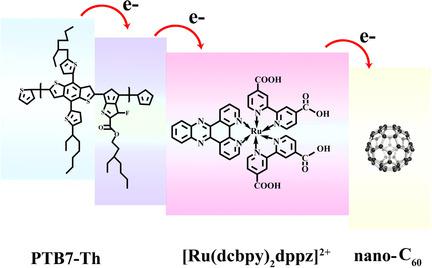当前位置:
X-MOL 学术
›
Chem. Eur. J.
›
论文详情
Our official English website, www.x-mol.net, welcomes your
feedback! (Note: you will need to create a separate account there.)
[Ru(dcbpy)2dppz]2+/Fullerene Cosensitized PTB7‐Th for Ultrasensitive Photoelectrochemical MicroRNA Assay
Chemistry - A European Journal ( IF 3.9 ) Pub Date : 2019-02-21 , DOI: 10.1002/chem.201806005 Ling‐Ying Xia 1 , Ying‐Ning Zheng 1 , Wen‐Bin Liang 1 , Meng‐Jie Li 1 , Tao Hu 1 , Ruo Yuan 1 , Ya‐Qin Chai 1
Chemistry - A European Journal ( IF 3.9 ) Pub Date : 2019-02-21 , DOI: 10.1002/chem.201806005 Ling‐Ying Xia 1 , Ying‐Ning Zheng 1 , Wen‐Bin Liang 1 , Meng‐Jie Li 1 , Tao Hu 1 , Ruo Yuan 1 , Ya‐Qin Chai 1
Affiliation

|
A new cosensitization photoelectrochemical (PEC) strategy was established by using a donor–acceptor‐type photoactive material, poly{4,8‐bis[5‐(2‐ethylhexyl)thiophen‐2‐yl]benzo[1,2‐b:4,5‐b′]dithiophene‐2,6‐diyl‐alt‐3‐fluoro‐2‐[(2‐ethylhexyl)carbonyl]thieno[3,4‐b]thiophene‐4,6‐diyl} (PTB7‐Th), as a signal indicator, which was cosensitized with bis(4,4′dicarboxyl‐2,2′‐bipyridyl)(4,5,9,14‐tetraazabenzo[b]triphenylene)ruthenium(II) ([Ru(dcbpy)2dppz]2+) embedded in the grooves of the DNA duplex and fullerene (nano‐C60) immobilized on the surface of DNA nanoflowers for microRNA assay. [Ru(dcbpy)2dppz]2+ and nano‐C60 could effectively enhance the photoelectric conversion efficiency (PCE) of PTB7‐Th as a result of well‐matched energy levels among nano‐C60, [Ru(dcbpy)2dppz]2+ and PTB7‐Th, leading to a clearly enhanced photocurrent signal. Meanwhile, a target recycling magnification technique based on duplex‐specific nuclease was applied in this work to obtain higher detection sensitivity. The proposed biosensor demonstrated excellent analytical properties within a linear detection range of 2.5 fm to 2.5 nm and a limit of detection down to 0.83 fm. Impressively, this cosensitization PEC strategy offers an effective and convenient avenue to significantly improve the PCE of a photoactive material, resulting in a remarkably improved photocurrent signal for ultrasensitive and highly accurate detection of various targets.
中文翻译:

[Ru(dcbpy)2dppz] 2 + /富勒烯共敏PTB7-Th用于超灵敏的光电化学MicroRNA分析
一个新的cosensitization光电化学(PEC)策略是通过使用供体-受体型光敏材料建立,聚{4,8-双[5-(2-乙基己基)噻吩-2-基]苯并[1,2- b: 4,5- b ']二噻吩-2,6-二基ALT -3-氟-2 - [(2-乙基己基)羰基]噻吩并[3,4- b ]噻吩-4,6-二基}(PTB7- Th),作为信号指示剂,与bis(4,4'dicarboxyl-2,2'-bipyridylyl)(4,5,9,14-tetraazabenzo [ b ] triphenylene)钌(II)([Ru( dcbpy)2 dppz] 2+)嵌入DNA双链体的凹槽中,富勒烯(nano-C 60)固定在DNA纳米花的表面上,用于microRNA分析。[Ru(dcbpy)2 dppz]2+和nano-C 60可以有效提高PTB7-Th的光电转换效率(PCE),这是因为nano-C 60,[Ru(dcbpy)2 dppz] 2+和PTB7-Th的能级非常匹配,导致光电流信号明显增强。同时,在这项工作中采用了基于双链特异性核酸酶的靶循环放大技术,以获得更高的检测灵敏度。所提出的生物传感器在2.5 f m至2.5 n m的线性检测范围内以及低至0.83 f m的检测限内均表现出出色的分析性能。令人印象深刻的是,这种共敏化PEC策略提供了一种有效且方便的途径,可以显着改善光敏材料的PCE,从而显着改善光电流信号,从而可以对各种目标进行超灵敏,高精度的检测。
更新日期:2019-02-21
中文翻译:

[Ru(dcbpy)2dppz] 2 + /富勒烯共敏PTB7-Th用于超灵敏的光电化学MicroRNA分析
一个新的cosensitization光电化学(PEC)策略是通过使用供体-受体型光敏材料建立,聚{4,8-双[5-(2-乙基己基)噻吩-2-基]苯并[1,2- b: 4,5- b ']二噻吩-2,6-二基ALT -3-氟-2 - [(2-乙基己基)羰基]噻吩并[3,4- b ]噻吩-4,6-二基}(PTB7- Th),作为信号指示剂,与bis(4,4'dicarboxyl-2,2'-bipyridylyl)(4,5,9,14-tetraazabenzo [ b ] triphenylene)钌(II)([Ru( dcbpy)2 dppz] 2+)嵌入DNA双链体的凹槽中,富勒烯(nano-C 60)固定在DNA纳米花的表面上,用于microRNA分析。[Ru(dcbpy)2 dppz]2+和nano-C 60可以有效提高PTB7-Th的光电转换效率(PCE),这是因为nano-C 60,[Ru(dcbpy)2 dppz] 2+和PTB7-Th的能级非常匹配,导致光电流信号明显增强。同时,在这项工作中采用了基于双链特异性核酸酶的靶循环放大技术,以获得更高的检测灵敏度。所提出的生物传感器在2.5 f m至2.5 n m的线性检测范围内以及低至0.83 f m的检测限内均表现出出色的分析性能。令人印象深刻的是,这种共敏化PEC策略提供了一种有效且方便的途径,可以显着改善光敏材料的PCE,从而显着改善光电流信号,从而可以对各种目标进行超灵敏,高精度的检测。





















































 京公网安备 11010802027423号
京公网安备 11010802027423号